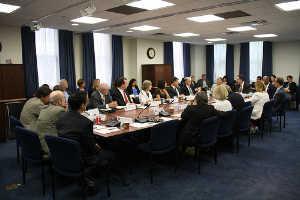EPA's Role in International Trade

- EPA Role in the Trade Agreement Process
- United States-Mexico-Canada Free Trade Agreement (USMCA)
- Trade and Environment Policy Advisory Committee
EPA Role in the Trade Agreement Process
Developing Environment-related Provisions in Proposed Trade Agreements
- minimize the domestic effects of cross-boundary pollutants, and
- ensure that U.S. industry has a level playing field on which to compete.
Implementing Trade Related Environmental Activities
- NAFTA: The North American Commission on Environmental Cooperation (CEC)
- Capacity-Building Programs Under the Dominican Republic-Central America-United States Free Trade Agreement (CAFTA-DR)
- EPA Collaboration with Singapore
Reviewing Environmental Effects of Proposed Agreements
- Environmental Reviews
- Executive Order 13141 (PDF) and its implementing guidelines (PDF)
In 2019, the United States-Mexico-Canada (USMCA) Free Trade Agreement was finalized to update and replace the North American Free Trade Agreement (NAFTA), which itself had been finalized in 1992 and operational as of 1994. With entry into force on July 1, 2020, and with combined trilateral trade flows of over $1.2 trillion, the USMCA creates the largest free trade area in the world outside of the European Union.
The USMCA features the strongest, most advanced and most comprehensive set of environmental obligations of any U.S. trade agreement. In contrast to the NAFTA, the USMCA environmental obligations are incorporated into the trade agreement itself rather than in a side agreement on environmental cooperation, as was done with NAFTA. Fully enforceable and subject to dispute resolution, the USMCA environmental obligations:
- require the Parties to effectively enforce their environmental laws,
- promote the protection of coastal and marine environments,
- seek to improve air quality,
- ensure market access for U.S. environmental technologies, goods and services,
- promote conservation and combats trafficking in wildlife, timber, and fish,
- require Parties to fulfill obligations under seven multilateral environmental agreements,
- promote public participation in implementation, and
- complement a modernized trilateral environmental cooperation agreement, replacing the North American Agreement on Environmental Cooperation (NAAEC).
Once the USMCA enters into force and replaces NAFTA and NAAEC on July 1, 2020, EPA will continue to work with a number of the institutions established originally by NAFTA and related agreements to address environmental issues in the North American region. This includes the mechanism, originally created in the NAAEC, allowing any non-governmental organization or person in any of the three countries to assert that one of the Parties (i.e., the United States, Canada, and Mexico) is failing to enforce its environmental laws. In addition, EPA will continue to work through the Commission for Environmental Cooperation (CEC) to address regional environmental concerns, help prevent potential trade and environmental conflicts, promote the effective enforcement of environmental law, and to monitor the environmental effects of the USMCA, as well as the North American Development Bank (NADB).
- North American Free Trade Agreement (NAFTA)
- North American Commission for Environmental Cooperation (CEC)
- EPA's Role with the North American Development Bank (NADB)
Trade and Environment Policy Advisory Committee
- Learn more about the Trade and Environment Policy Advisory Committee (TEPAC)
Contacts
U.S. Environmental Protection Agency
Office of International and Tribal Affairs (2660R)
1200 Pennsylvania Ave., NW
Washington, DC 20460
202-564-6600
E-mail: muehling.brian@epa.gov
